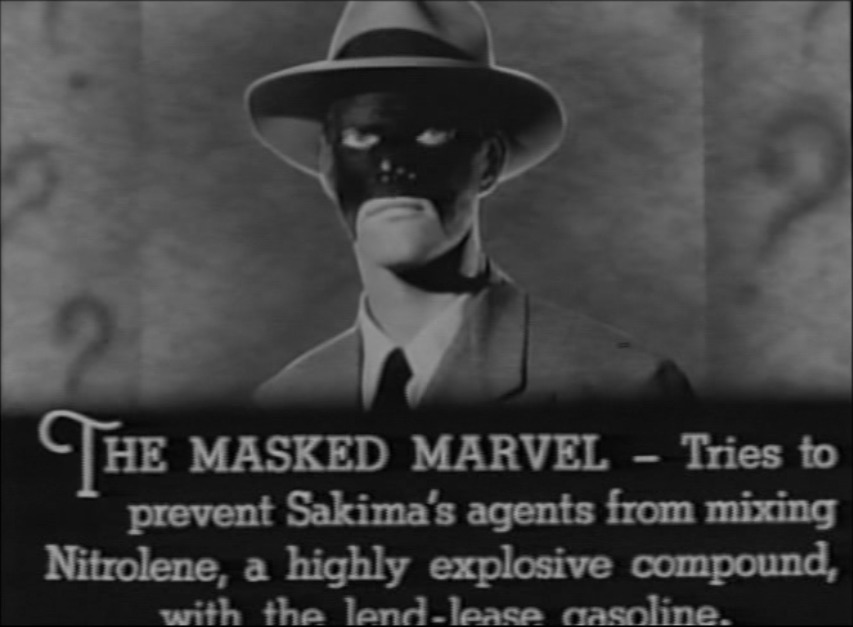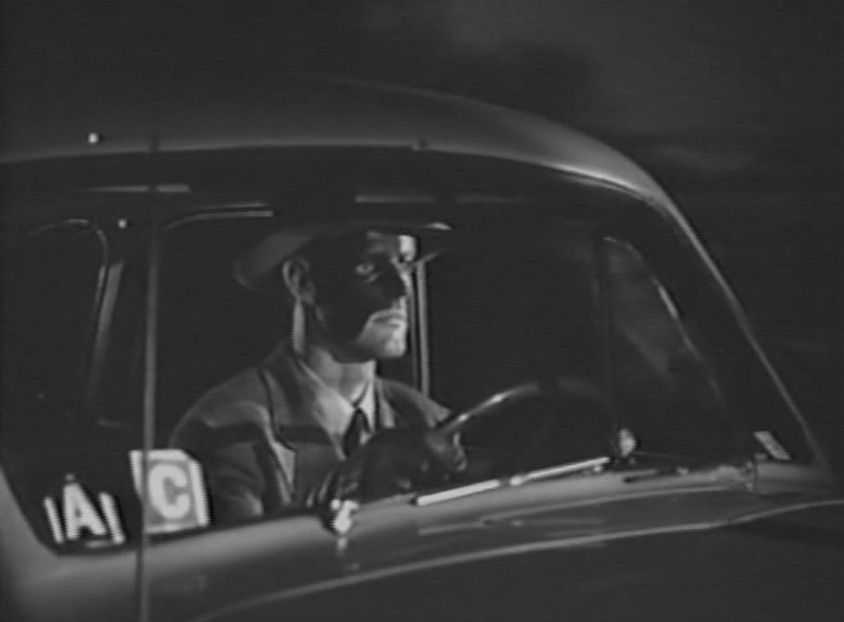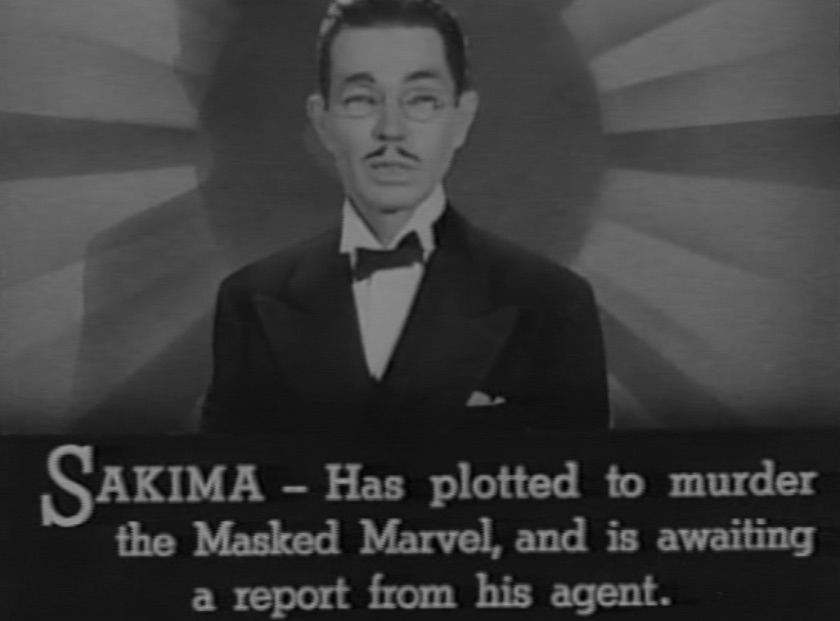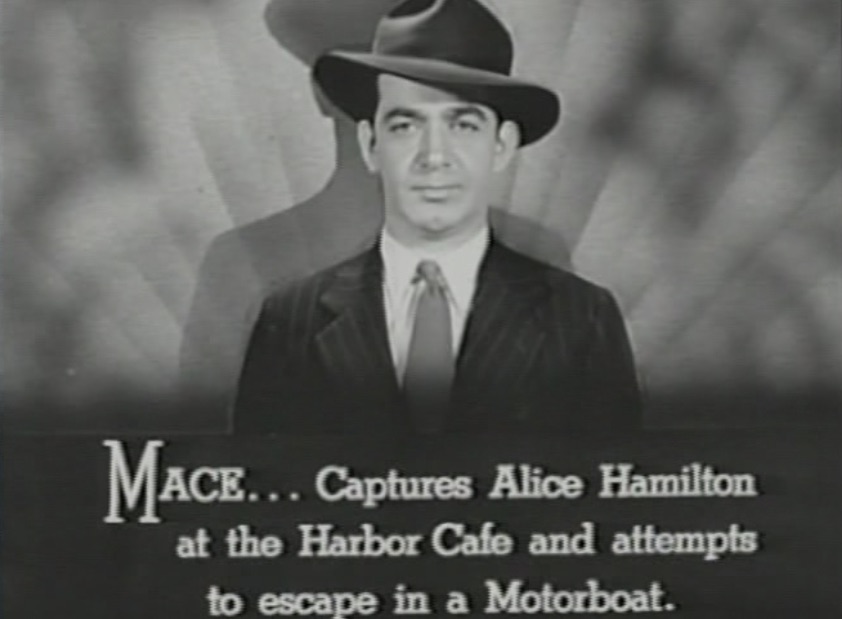Saturday November 23, 2019
Movie Review: The Masked Marvel (1943)
WARNING: SPOILERS
In many of the ur-superhero movie serials of the 1930s and ’40s, specifically “The Spider’s Web,” “The Shadow” and “The Green Hornet,” the true identity of the masked villain is unknown, and the likely suspects, a group of nondescript business leaders meeting regularly around a table, keep dropping like flies until we get the Big Reveal in the final chapter. Ah. Him. Sure.
“The Masked Marvel” reverses this conceit. It was 1943 so we knew who the villain was: Japan, here in the form of Mura Sakima (Johnny Arthur in yellowface), who, according to a helpful radio announcer in the first chapter, is “formerly Tokyo representative of the Worldwide Insurance Company, and secretly head of the Japanese espionage service...”
(Wait: Secretly? It’s on the radio. How secret can it be?)
 What we don’t know is who the hero is. We’re told the Masked Marvel is one of four “ace investigators” for the same insurance company, all of whom are about the same size, with the same wide-shouldered gray suits, gray fedoras and gray personalities. But only one of them periodically puts on a black rubber face mask to fight crime as the Masked Marvel. But which one?
What we don’t know is who the hero is. We’re told the Masked Marvel is one of four “ace investigators” for the same insurance company, all of whom are about the same size, with the same wide-shouldered gray suits, gray fedoras and gray personalities. But only one of them periodically puts on a black rubber face mask to fight crime as the Masked Marvel. But which one?
Here’s the burden of the home entertainment age: I actually tried to figure it out—pausing and rewinding, comparing and contrasting. I thought: “Well, that one’s got personality ... but is that to throw us off the track? Besides, his face isn’t lean enough. How about the one with the Southern accent? Or the stiff one with the Brooklyn accent? He’s the least likely, so ... maybe the most likely?”
Anyway, in the final chapter, we find out it’s the one with personality, Bob Barton (David Bacon). Ah. Him. Sure.
Except, in truth, the Masked Marvel was none of the above. He’d always been stuntman Tom Steele, nee Thomas Skeoch, born in Scotland in 1909, who was such a staple at Republic Pictures that some serial stars were chosen because of their resemblance to him, the stunt man, rather than vice versa. IMDb lists 440 stunt credits for him: from the Zane Grey-based “Lone Star Ranger” in 1930 to “The Blues Brothers,” “Scarface” and “Tough Guys” in the 1980s. Helluva career. He also has 219 acting credits, bit parts mostly. You might know him as the man who falls off the chair when Sheriff Black Bart rides into town in “Blazing Saddles.” Yeah, that’s the Masked Marvel. Tell your friends.
Except Steele was only the body of the Masked Marvel. His stentorian voice actually belonged to Gayne Whitman, nee Alfred Vosburgh, born in Chicago in 1890, who started out in silent movies, often fourth-billed, went on to minor, uncredited roles in ’30s talkies, then became a longtime radio announcer—voicing Chandu the Magician among others. I find this fascinating. Think about it: He had success in the silents, where he was seen but not heard; and on the radio, where he was heard but not seen; but less success in the talkies when you put the two together. He died in 1958. His New York Times obit is a paragraph long.
So we begin the serial trying to figure out which of four men is the Masked Marvel, and it turns out, on the production side, he’s three men. And the third, Bob Barton/David Bacon, is the most fascinating of all. And the most tragic.
Maguffins and traitors
Thanks to that helpful radio announcer, we learn a lot in the first few minutes of the serial. He lets us know about Sakima; then he lets us know that the Masked Marvel, a Republic Pictures invention, is already a legendary figure “who smashed the greatest crime ring the world has ever seen.”
Then he’s maybe a little too helpful.
He announces that the president of the Worldwide Insurance Company, Warren Hamilton (Howard Hickman), will deliver documents to the Masked Marvel with info that will lead to Sakima’s capture. Of course, Sakima is listening in. (Sakima is always listening in.) And Sakima sends his goons, including Killer Mace (Anthony Warde), to retrieve the documents. For good measure, they kill Hamilton in front of his daughter, Alice (Louise Currie), who cries out “Dad! Dad!” but seems to get over it pretty fast. In the aftermath, Martin Crane (William Forrest, top-billed), becomes the new president of the insurance company; the Masked Marvel shows up at the Hamilton place to keep “photostatic reproductions” from Mace; four same-sized investigators arrive to help protect Alice and the company; and the Masked Marvel returns to reveal his secret identity to Alice—but not to us.
Crane, by the way, is really working for Sakima. Which means the top-billed guy is the villain. And a traitor to America.
That’s always bugged me about these World War II-era serials with Japanese villains and American henchmen. It’s not like they’re doing dirty work for the usual masked underworld figure. They’re helping their country’s enemy defeat their country. Are they that dumb? Greedy? Short-sighted? I know it’s asking a lot of slap-dash serials, but you’d think someone would raise the issue at some point—like in Chapter 3 when Mace says it’s impossible to ambush a bullet-proof car and Sakima replies, “Nothing is impossible for the Japanese!” Or in Chapter 4 when they steal diamonds and Sakima says, “How unfortunate we cannot get these to Japan. They would be so useful to my people.” No second glances, Mace? No epiphany? No “Hey, wait a minute...”
As usual with serials, each episode has a new maguffin added, necessitating the good guys and bad guys converge, clash and cliffhang. In one chapter, they fight over a newly designed periscope; in another, precision parts for U.S. bombers. They tussle at an airplane factory, a seaside café, the rooftop of the Super-X Products Co., and at the Ferndale train depot.
Meanwhile, our insurance investigators get winnowed down. At the end of Chapter 8, it looks like the Masked Marvel is pushed from a rooftop but it’s really Jim Arnold, who isn’t the Masked Marvel. In Chapter 10, Frank Jeffers discovers Crane is in league with Sakima but is shot trying to get away. My favorite bit is when he radios ahead to Alice:
“Alice, tell the others ... they’re planning to blow up the train ... with the bomber parts ... just outside ... Ferndale. The man behind all this is ... uhhh ...”
I can just see 10-year-old boys in matinees across the country slapping their foreheads over that one
For completists, here are the cliffhangers:
| No. | Chapter Title | Cliffhanger | Escape |
| 1 | The Masked Crusader | MM is punched from a rooftop into a flaming truck, which blows up | He wakes up and runs away before the explosion |
| 2 | Death Takes the Helm | He fights a bad guy on a boat laden with explosives | Jumps out in time |
| 3 | Dive to Doom | Killer Mace punches MM down elevator shaft | The elevator is 10 feet below |
| 4 | Suspense at Midnight | Villain announces the identity of MM | He's wrong |
| 5 | Murder Meter | A bomb goes off in an aeroplane factory tunnel | MM escapes |
| 6 | Exit to Eternity | A truck, driving straight at MM, crashes through a wall | MM sidesteps it |
| 7 | Doorway to Destruction | Killer Mace shoots a rifle through a door and MM falls | He's not hit |
| 8 | Destined to Die | MM falls from a rooftop | It was Jim Arnold |
| 9 | Danger Express | MM is trapped in truck that goes over ravine | Elaborate! MM ties a rope to the truck's door and then around a passing tree, so the door is ripped off, allowing him to escape |
| 10 | Suicide Sacrifice | MM's car collides with train | He'd already jumped out |
| 11 | The Fatal Mistake | A live hand grenade drops on a boat with an unconscious Alice | She wakes up and dives off |
| 12 | The Man Behind the Mask | n/a | n/a |
The fight scenes aren’t bad. Amusingly, no one’s hat ever goes flying off—I guess that was a Tom Steele trademark. I particularly like the Frank Jeffers fight in the basement of Crane’s place in Chapter 10, although the double for Sakima is too big. I also like how Crane’s desk chair lowers into Sakima’s lair like a precursor to the Adam West batpole.
Feminists can take pride in the Chapter 3 cliffhanger. At first, it seems like the usual damsel-in-distress deal. Killer Mace and his goons have Alice tied up, crush a barrel beneath an elevator and say the same thing will happen to her if she doesn’t talk. She doesn’t. So she’s put in the elevator pit. “Bring it down ... slowly,” Mace says. Classic cliffhanger. Except that’s not the cliffhanger. The Masked Marvel shows up, stops the elevator, kills the guy operating it, and follows the bad guys to the 5th floor for yet another slugfest. In the meantime, Alice frees herself. The cliffhanger is when Mace punches the Masked Marvel into the elevator shaft. What saves him is ... Alice. She’s taking the elevator up to help him, so he only falls like 10 feet.
Another interesting sidenote. When the Masked Marvel finally catches up with Sakima in Chapter 12, he says this: “Alive or dead, you’re coming with me.” It’s almost word for word the catchphrase for 1987’s Robocop. Did they get it from here? It seems like it would be a common-enough action-hero phrase, yet I haven’t heard it anywhere else.
The lonesome death of Gaspar Griswold Bacon, Jr.
That said, there’s not much here here. The top-billed guy is an American traitor, Louise Currie is not my favorite serial heroine, while our hero is split into the three aforementioned parts: actor, voice, stunt man. Plus he’s not someone we imagined first on the radio or in comic books. He’s not Batman or The Shadow or even Green Hornet; he’s someone Republic Pictures imagined to make a buck. He’s basically a guy who looks like the Spirit but without the Spirit’s cool name or cool extras. Did Will Eisner contemplate a lawsuit? Or were guys in suits, fedoras and facemasks too common back then?
Some background on David Bacon, nee Gaspar Griswold Bacon, Jr., who came from a prominent Boston Brahmins family. His grandfather, Robert Bacon, was a business lieutenant to J.P. Morgan, ambassador to France, and briefly U.S. Secretary of State under Teddy Roosevelt. His father, Gaspar Griswold, Sr., was the president of the Massachusetts Senate in the 1920s and lieutenant governor in the 1930s.
David was educated at Harvard but went into acting—one assumes against family wishes. He became part of a theater troupe that included Jimmy Stewart and Henry Fonda. Two years after Harvard, he moved to LA, and a few years later he was signed to a contract by Howard Hughes, who was thinking of him for Billy the Kid in “The Outlaw.” Instead, David got bit parts before Hughes loaned him out for this. “The Masked Marvel” opened on Nov. 6, 1943, but David wasn’t there to promote it or see it. He’d been dead for two months. Murdered. Literally stabbed in the back.
His death was written up in the Sept. 14, 1943 New York Times under the headline: “D.G. BACON IS SLAIN AS IN MOVIE ROLES”:
Clad in blue denim shorts and returning from a swim, Mr. Bacon lost control of his small, English-built automobile. It bounced over the curb and stopped [in a bean field]. He climbed out and collapsed. He died of a stab wound in the back, gasping his plea to Wayne Powell, a passer-by.
Witnesses said that Mr. Bacon’s car wavered along Washington Boulevard before leaping the curb. One woman said that she saw a black-haired man in the vehicle beside the driver, while a service station attendant a half mile west of the bean field said that a man and a woman, besides the driver, were in the car when it passed his place.
A few days later, the Times printed a UP story about how Bacon wrote a penciled will three months before his death, as if he were anticipating it. He left everything to his wife, Greta Keller, an Austrian concert singer 11 years his senior.
The bigger reveal came years later from his widow: He was gay, she was gay, theirs was a lavender marriage. There were other reveals, too. The cops found a camera in his car with one photo taken—David, on the beach, in the nude. Someone came forward saying David was being blackmailed. His widow thought Howard Hughes was involved. As with any Hollywood death, theories abound. It might make a good movie someday.
As for the Masked Marvel, this was it for him. One and done. Beyond the Green Hornet, masked men in suits and fedoras just didn’t survive into the true superhero age. One wonders if anyone still owns the rights to him.
Baseball's Active Leaders, 2023
What Trump Said When About COVID
Recent Reviews
Everything Everywhere All at Once (2022)
Black Panther: Wakanda Forever (2022)
Doctor Strange in the Multiverse of Madness (2022)
Spider-Man: No Way Home (2021)
The Cagneys
A Midsummer Night's Dream (1935)
Something to Sing About (1937)
Angels with Dirty Faces (1938)
A Lion Is In the Streets (1953)
Man of a Thousand Faces (1957)
Never Steal Anything Small (1959)
Shake Hands With the Devil (1959)
















